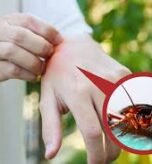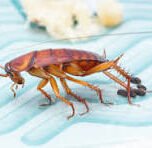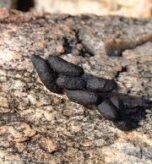While the thought of a cockroach bite may cause significant concern, these incidents are, in fact, quite rare. However, understanding the broader health implications of a cockroach infestation is crucial for maintaining a safe and hygienic home. These resilient pests are known for their unsanitary habits, which can pose serious health risks that go far beyond a simple bite, including disease transmission and the worsening of allergies.
Understanding the Cockroach: A Common Household Pest
Cockroaches are nocturnal omnivores with distinct behaviors that make them such a persistent pest.
Identifying the German Cockroach
The adult German cockroach is light brown and measures between 13 to 16 mm long. A key feature is the two black horizontal stripes located behind its head. While adults have wings, they rarely fly, preferring to run. You can often identify their presence by their droppings, egg capsules, and a distinct musty odor.
Nocturnal Nature and Dietary Habits
Cockroaches are primarily active at night, emerging from their hiding spots to search for food and water. As omnivores, they are attracted to a wide array of organic materials, including food crumbs, grease, decaying matter, and even the glue in book bindings.
The Reality of a Cockroach Bite
While the idea of a cockroach bite can be unsettling, it is important to understand that such incidents are not common.
How Rare Are Cockroach Bites?
A cockroach bite is exceedingly rare. These insects are shy and will actively avoid humans, preferring to flee rather than engage. Bites typically only occur under extreme conditions, such as in a severe infestation where the cockroach population is exceptionally large and their usual food sources have become scarce.
Why a Cockroach Might Bite You
When a cockroach does bite, it is motivated by a search for food. It may nibble on readily available organic matter like dead skin, fingernails, or food crumbs left on your hands or face, particularly while you are asleep.
What Does a Cockroach Bite Look Like?
A cockroach bite generally appears as a small, red, raised bump on the skin, often with some itchiness. The bites are typically larger than bed bug bites and usually appear as isolated marks rather than in clusters. The initial sensation might be a slight pinch, and the discomfort usually does not last long.
The Health Risks of a Cockroach Bite and Infestation
Beyond the immediate discomfort of a bite, cockroaches pose numerous health risks, primarily through contamination and allergens.
Are Cockroach Bites Venomous?
It is important to clarify that a cockroach bite is not venomous or poisonous. The danger associated with them comes from other factors, not from injected toxins.
Allergic Reactions and Asthma Triggers
Cockroaches are a major source of indoor allergens. The enzymes in their saliva, feces, and shed body parts can trigger allergic reactions and worsen asthma symptoms in many people. Symptoms can include skin rashes, sneezing, itchy eyes, and coughing.
The Risk of Infection and Disease
If you scratch a cockroach bite excessively, there is a risk of a secondary bacterial infection. Cockroaches are well-documented carriers of harmful bacteria, viruses, and parasites. They pick up these pathogens from unsanitary environments and can transfer them to your food and kitchen surfaces. This can lead to illnesses such as salmonellosis (food poisoning), E. coli infections, and typhoid fever.
How to Treat a Cockroach Bite
If a cockroach bite does occur, prompt and proper treatment can mitigate discomfort and prevent complications.
Immediate Care for a Bite
The first step is to wash the affected area thoroughly with mild soap and warm water to reduce the risk of infection. It is crucial to avoid scratching the bite. Applying a cold compress can help reduce swelling and relieve itching.
Home Remedies for a Cockroach Bite
Several home remedies can provide relief.
- Antiseptic Cream: Applying a topical antiseptic can help prevent infection.
- Aloe Vera Gel: This can be applied to soothe itching and irritation.
- Baking Soda Paste: A paste made from baking soda and water can help reduce itchiness.
- Over-the-Counter Antihistamines: For more severe itching, oral antihistamines can be effective.
When to See a Doctor for a Bite
While most bites heal quickly, you should seek medical attention if symptoms worsen or if you see signs of infection, such as increased swelling, pus, or fever.
How to Prevent a Cockroach Bite by Preventing Infestations
The most effective strategy to avoid a cockroach bite is to prevent an infestation in the first place.
- Maintain a Clean Home: Promptly clean up food crumbs and spills. Store all food in airtight containers and take out the garbage regularly.
- Control Moisture: Cockroaches are highly attracted to moisture. Fix any leaky pipes and ensure your home has good airflow to reduce humidity.
- Seal Entry Points: Prevent cockroaches from getting inside by sealing any cracks or gaps in your foundation, walls, and around plumbing fixtures.
- Reduce Clutter: Eliminate hiding spots by regularly decluttering your home, especially storage areas.
When to Call a Professional
While DIY methods can offer temporary relief, they often do not address the root cause of an infestation. For effective and long-term elimination, you should engage a professional pest control service. They can conduct a thorough inspection and provide a tailored plan for lasting protection.
Conclusion
Although a cockroach bite is a rare event, the primary danger of these pests lies in their ability to contaminate our living spaces and spread harmful bacteria and allergens. By adhering to rigorous sanitation practices, eliminating moisture sources, and sealing entry points, you can significantly reduce the risk of an infestation. For persistent problems, professional pest control is the most effective solution for a healthier, cockroach-free home.




